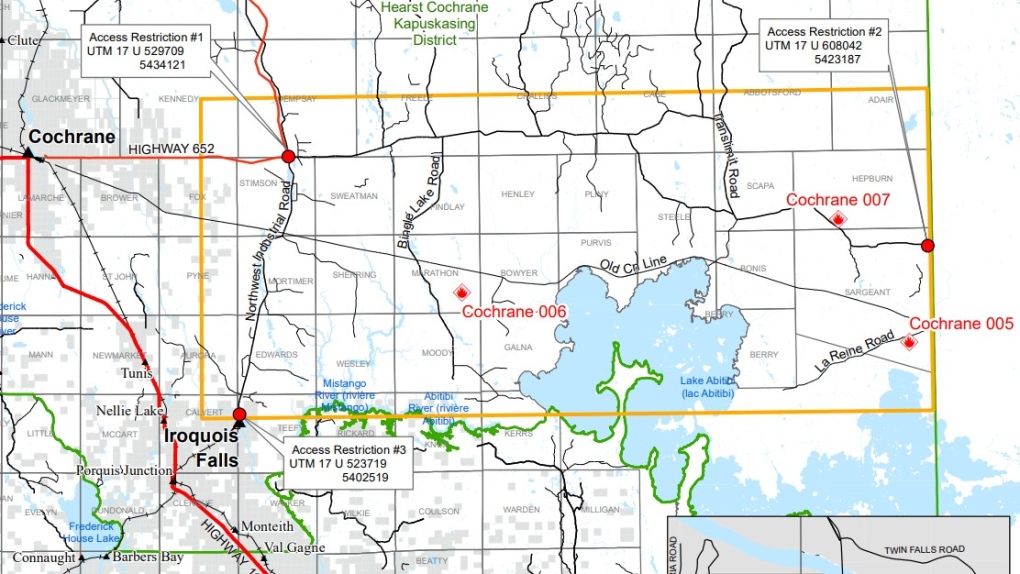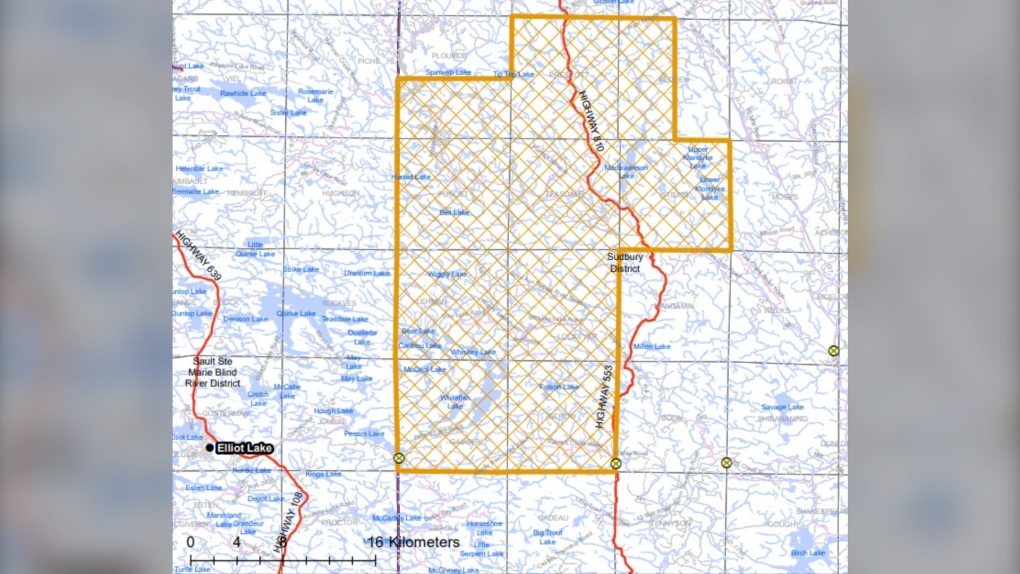
Wildfires have burned more than 110,000 hectares in Ontario
With the sunshine and warmer temperatures over the weekend, the fire hazard in northeastern Ontario has returned to high as the number of active and out-of-control fires continues to decrease.
Last week, northeastern Ontario got some much-needed rain which temporarily lowered the danger rating, but the restricted fire zone remained in effect.
As of Monday morning, there are 51 active wildfires in northern Ontario – 20 in the northeast and 31 in the northwest – down from 67 the previous week.
Two of the three new fires in the last 24 hours began in the northeast, where there are 12 not yet under control.
The number of fires not yet under control in the northwest has decreased to eight.
There have been 278 wildfires since April 12 that have burned around 110,675 hectares (ha) and 227 of the fires have been extinguished. The number of fires is more than triple the total in 2022.
The restricted fire zone and fire ban remain in place for the region despite the forest fire danger rating in the northeast dropping to low.
"One thing (Aviation, Forest Fire and Emergency Services) is doing is we’re continuing to monitor the landscape for holdover lightning, because this is lightning that can strike the ground and cause an under, almost beneath the surface ignition, and so fire management staff are still on the lookout for these hold over lightening fires," Kyle Hayward of the Ontario Ministry of Natural Resources and Forestry to CTV News in an interview.
COCHRANE 7
North of Lake Abitibi and east of Iroquois Falls near the Quebec border, Cochrane 7 still burns out of control and remains at 10,720 ha in size, the largest in the northeast region.
Cochrane 7 started June 2 and on Tuesday, the Ministry of Natural Resources and Forestry declared travel, use and access restrictions for the area.
 Travel, use and access restrictions in place for areas north of Lake Abitibi due to three forest fires. June 4/23 (Ontario Ministry of Natural Resources and Forestry)
Travel, use and access restrictions in place for areas north of Lake Abitibi due to three forest fires. June 4/23 (Ontario Ministry of Natural Resources and Forestry)
Gabrielle Ayres, an MNRF fire information officer for the Cochrane District, told CTV News in a phone interview that people in the implementation area near Cochrane 5, 6 and 7 are not being forced to evacuate at this time.
Ayres said the required travel permits allow the ministry to know where people are as firefighters continue to battle the blaze and keep them safe.
"Construction of dozer guards along the south end and western flank are ongoing to help contain the fire. The fire is 90 km east of Cochrane," the ministry said.
"If you have any questions or require travel permits, please contact the Hearst-Cochrane-Kapuskasing District office at 705-272-7178 or by email mnrf.coc@ontario.ca."
Highway 652 has fully reopened after being partially closed due to nearby wildfires.
SUDBURY 17
The third largest fire in the northeast is Sudbury 17 located about 55 kilometres north of Massey, which is about 96 km west of Greater Sudbury. Sudbury 17 is at 5,857 ha and is not yet under control.
Fire crews are allocated to this fire. It has grown about 600 ha since last week.
There is an evacuation order in place for communities around Highway 810, which is closed.
- Facing evacuations due to a forest fire or flood? Here's what to pack in a grab-and-go bag
- Here's what you need to do before you leave your house in a forest fire-prompted evacuation
 Evacuation area due to wildfire Sudbury 17. June 7/23 (Ontario Ministry of Natural Resources and Forestry)
Evacuation area due to wildfire Sudbury 17. June 7/23 (Ontario Ministry of Natural Resources and Forestry)
The Hwy. 810 closure has been expanded south to include an approximate two km stretch of Highway 553 to Tertiary Road.
MNRF also has travel, access and use restrictions in place.
Meanwhile in Elliot Lake, provincial police and city officials said in a news release Friday, "there is currently no need for an evacuation" in their community.
"The public will be notified immediately if this changes. (Elliot Lake) Fire Chief John Thomas is in constant contact with Ministry of Natural Resource crews who are actively working on the SUD#017 fire," Ontario Provincial Police said.
"Additional information will be provided when it becomes available should the situation change."
WAWA 3
The second largest fire in northeastern Ontario is Wawa 3 near White River. The fire is being held at 6,678 ha. An implementation order was placed on June 4 restricting travel in areas where active fire and fire suppression are taking place.
FIRES OF NOTE
Chapleau 3 is located east of Chapleau, remains 3,916 hectares in size and not under control. Values assessment and protection are ongoing. Helicopter bucket operations took place yesterday to work priority areas on the fire. Travel, use and access restrictions have been put in place for this area.
"If you have any questions or require travel permits, please contact the Chapleau-Wawa District Office at 705-856-2396," the MNRF said.
Kirkland Lake 5 remains at 2,300 hectares not under control north of Lady Evelyn Lake. Value assessment and protection are ongoing.
Sudbury 10 started June 2 east of Spanish River Provincial Park north of Espanola and has grown about 300 ha to 1,370 ha.
Chapleau 6 remains 1,239 hectares and is located about 48 km northwest of Chapleau and about 15.7 km west of the southern point of Missinaibi Provincial Park.
Sudbury 19 started June 4 west of the same provincial park and has increased a bit to 459 ha.
Timmins 7 is currently sized at 149 hectares west of Mattagami First Nation currently not under control. Crews have established hose lines on the south end of the fire.
CTVNewsNorthernOntario.ca will continue to have daily and breaking news updates as the forest fire situation continues.
- Download our app to get local alerts on your device
- Get the latest local updates sent right to your inbox
REGIONAL FIRE BAN STILL IN EFFECT
Most of northern Ontario remains a restricted fire zone that prohibits open-air burning, including campfires.
"Portable gas or propane stoves may be used for cooking and warmth BUT must be handled with extreme caution," MNRF said.
Since the regional ban took effect last week, three people have been charged for having campfires which comes with an $880 fire. Two others were charged for breaking the municipal fire ban in Elliot Lake on May 31.
AIR QUALITY
CTVNews.ca Top Stories

Feature Report What's the best advice for Canadians with renewing mortgages? More than 50 brokers weigh in
Over the next year-and-a-half, 44 per cent of all mortgages will be up for renewal in Canada. To help guide consumers through these uncertain financial times, CTV News reached out to more than 50 mortgage brokers across Canada with a list of questions. Their answers provide professional guidance for individuals and families searching for clarity and sound advice.
Bread, milk, apples: Federal NDP wants price cap for grocery store staples
The federal New Democrats want a price cap on grocery store staples if the Liberal government can't convince grocers to bring down the prices themselves.
Mourners can now speak to an AI version of the dead. But will that help with grief?
A 61-year-old startup entrepreneur teamed up with his friend in the U.S., Robert LoCascio, CEO of the AI-powered legacy platform Eternos. Within two months, they built "a comprehensive, interactive AI version" of Michael Bommer -- the company's first client.
National Bank of Canada seizes Ont. woman's car by mistake
A university student woke up one morning to find her car had been towed away without warning. She finally got answers - just not the ones she expected.
North Korea's trash balloons deepen tensions with the South. Here's what's happening between rivals
Animosities between North and South Korea are rising sharply again over an unusual cause: The North's rubbish-carrying balloons.
Her gut was producing alcohol. Doctors didn't believe her
For two years doctors told her she was an alcoholic. Then they realized her gut was making alcohol from carbohydrates, a rare condition called auto-brewery syndrome.
Forest bathing: What it is and why some Alberta doctors recommend it
Many people are familiar with the benefits of being in nature, but forest therapy goes a step further than a simple walk in the woods.
India election: Modi's coalition leads in early count but opposition is stiffer than expected
Prime Minister Narendra Modi's coalition led in a majority of seats Tuesday in India's general election, according to early figures, but faced a stronger challenge from the opposition than expected after it pushed back against the leader's mixed economic record and polarizing politics.
Poilievre disagrees with Conservative MP who opposes same-sex marriage, vows to uphold
Facing scrutiny over comments one of his MPs made, Conservative Leader Pierre Poilievre says if he become prime minister, he will uphold same sex marriage rights, 'full stop.'





























